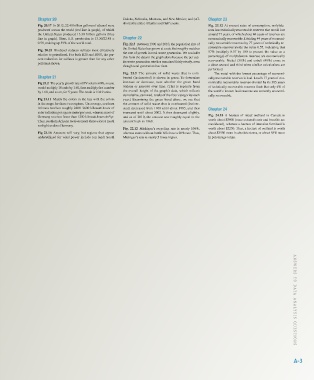Page 704 - Environment: The Science Behind the Stories
P. 704
Chapter 20 Dakota, Nebraska, Montana, and New Mexico; and (off- Chapter 23
shore) the entire Atlantic and Gulf coasts.
Fig. 20.17 In 2012, 22.48 billion gallons of ethanol were Fig. 23.12 At present rates of consumption, molybde-
produced across the world (red line in graph), of which num has technically recoverable reserves that would last
the United States produced 13.30 billion gallons (blue around 77 years, of which about 44 years of reserves are
line in graph). Thus, U.S. production is 13.30/22.48 = Chapter 22 economically recoverable. Dividing 44 years of economi-
0.59, making up 59% of the world total. Fig. 22.3 Between 1990 and 2010, the population size of cally recoverable reserves by 77 years of technically re-
Fig. 20.21 Biodiesel reduces sulfates most effectively the United States has grown at a rate that roughly matches coverable reserves yields the value 0.57, indicating that
57% (multiply 0.57 by 100 to present the value as a
relative to petrodiesel. For both B20 and B100, the per- the rate of growth in total waste generation. We can infer percentage) of molybdenum reserves are economically
cent reduction for sulfates is greater than for any other this from the data in the graph alone because the per cap- recoverable. Nickel (51%) and cobalt (49%) come in
pollutant shown. ita waste generation rate has remained fairly steady, even
though total generation has risen. a close second and third when similar calculations are
performed.
Fig. 22.5 The amount of solid waste that is com- The metal with the lowest percentage of economi-
Chapter 21 busted (incinerated) is shown in green. To determine cally recoverable reserves is lead. Lead’s 17 years of eco-
Fig 21.2 The yearly growth rate of PV solar is 60%, so you increase or decrease, note whether the green band nomically recoverable reserves divided by its 385 years
would multiply 10 units by 1.60, then multiply that number widens or narrows over time. (This is separate from of technically recoverable reserves finds that only 4% of
by 1.60, and so on, for 5 years. The result is 104.9 units. the overall height of the graph’s data, which reflects the world’s known lead reserves are currently economi-
cumulative, summed, totals of the four categories each cally recoverable.
Fig 21.11 Match the colors in the key with the colors year.) Examining the green band alone, we see that
in the maps for these two regions. On average, southern the amount of solid waste that is combusted (inciner-
Arizona receives roughly 2400–2600 kilowatt-hours of ated) decreased from 1960 until about 1985, and then Chapter 24
solar radiation per square meter per year, whereas most of increased until about 2002. It then decreased slightly,
Germany receives fewer than 1200 kilowatt-hours /m /yr. and as of 2010, the amount was roughly equal to the Fig. 24.18 A hectare of intact wetland in Canada is
2
Thus, southern Arizona receives more than twice as much amount back in 1960. worth about $5800 (once external costs and benefits are
sunlight as does Germany. considered), whereas a hectare of intensive farmland is
Fig. 22.12 Michigan’s recycling rate is nearly 100%, worth about $2250. Thus, a hectare of wetland is worth
Fig 21.16 Answers will vary, but regions that appear whereas states without bottle bills have a 20% rate. Thus, about $3550 more in absolute terms, or about 58% more
underutilized for wind power include (on land) South Michigan’s rate is nearly 5 times higher. in percentage terms.
ANSWER S T O D ATA AN ALYSI S QUESTI ONS
A-3
Z01_WITH7428_05_SE_AppA.indd 3 13/12/14 10:47 AM

